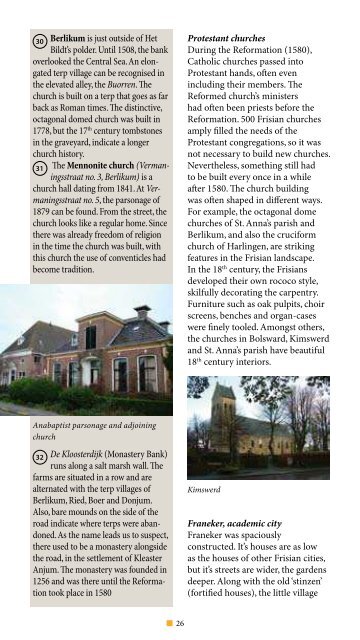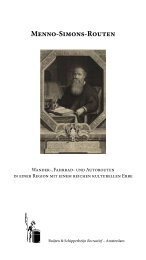Download - The Menno Simons routes - Doopsgezinde Monumenten
Download - The Menno Simons routes - Doopsgezinde Monumenten
Download - The Menno Simons routes - Doopsgezinde Monumenten
Create successful ePaper yourself
Turn your PDF publications into a flip-book with our unique Google optimized e-Paper software.
30 Berlikum is just outside of Het<br />
Bildt’s polder. Until 1508, the bank<br />
overlooked the Central Sea. An elongated<br />
terp village can be recognised in<br />
the elevated alley, the Buorren. <strong>The</strong><br />
church is built on a terp that goes as far<br />
back as Roman times. <strong>The</strong> distinctive,<br />
octagonal domed church was built in<br />
1778, but the 17th century tombstones<br />
in the graveyard, indicate a longer<br />
church history.<br />
31 <strong>The</strong> <strong>Menno</strong>nite church (Vermaningsstraat<br />
no. 3, Berlikum) is a<br />
church hall dating from 1841. At Vermaningsstraat<br />
no. 5, the parsonage of<br />
1879 can be found. From the street, the<br />
church looks like a regular home. Since<br />
there was already freedom of religion<br />
in the time the church was built, with<br />
this church the use of conventicles had<br />
become tradition.<br />
Anabaptist parsonage and adjoining<br />
church<br />
32 De Kloosterdijk (Monastery Bank)<br />
runs along a salt marsh wall. <strong>The</strong><br />
farms are situated in a row and are<br />
alternated with the terp villages of<br />
Berlikum, Ried, Boer and Donjum.<br />
Also, bare mounds on the side of the<br />
road indicate where terps were abandoned.<br />
As the name leads us to suspect,<br />
there used to be a monastery alongside<br />
the road, in the settlement of Kleaster<br />
Anjum. <strong>The</strong> monastery was founded in<br />
1256 and was there until the Reformation<br />
took place in 1580<br />
Protestant churches<br />
During the Reformation (1580),<br />
Catholic churches passed into<br />
Protestant hands, often even<br />
including their members. <strong>The</strong><br />
Reformed church’s ministers<br />
had often been priests before the<br />
Reformation. 500 Frisian churches<br />
amply filled the needs of the<br />
Protestant congregations, so it was<br />
not necessary to build new churches.<br />
Nevertheless, something still had<br />
to be built every once in a while<br />
after 1580. <strong>The</strong> church building<br />
was often shaped in different ways.<br />
For example, the octagonal dome<br />
churches of St. Anna’s parish and<br />
Berlikum, and also the cruciform<br />
church of Harlingen, are striking<br />
features in the Frisian landscape.<br />
In the 18 th century, the Frisians<br />
developed their own rococo style,<br />
skilfully decorating the carpentry.<br />
Furniture such as oak pulpits, choir<br />
screens, benches and organ-cases<br />
were finely tooled. Amongst others,<br />
the churches in Bolsward, Kimswerd<br />
and St. Anna’s parish have beautiful<br />
18 th century interiors.<br />
Kimswerd<br />
Franeker, academic city<br />
Franeker was spaciously<br />
constructed. It’s houses are as low<br />
as the houses of other Frisian cities,<br />
but it’s streets are wider, the gardens<br />
deeper. Along with the old ‘stinzen’<br />
(fortified houses), the little village<br />
has a ‘majestic’ feel to it.<br />
<strong>The</strong> foundations were laid in the<br />
Middle Ages. <strong>The</strong>re must have already<br />
been a tuff church there in 1805.<br />
It was donated to St. Jan’s chapter<br />
of Utrecht, and ever since, bishops<br />
from Utrecht and Dutch Dukes had<br />
to introduce themselves in Franeker,<br />
before being acknowleged as lords<br />
by the Frisians. Self-confident, the<br />
little town proclaimed itself a city<br />
in 1290. Several noble families settled<br />
within the city and had fortified<br />
houses built, called ‘stinzen’. Ten<br />
years after Leiden’s university was<br />
founded, Franeker established Holland’s<br />
second university (1585). <strong>The</strong><br />
academy was established at the end<br />
of the Reformation, because of a<br />
great need for pastors, after the Catholics<br />
were driven from the pulpits.<br />
In the 17 th century, Anna Maria van<br />
Schurman was the only woman<br />
to attend lectures at the Franeker<br />
university. Since this was a right<br />
reserved to men, she had to attend<br />
the classes sitting behind a wooden<br />
partition. This theologian became<br />
one of the few famous women of the<br />
17 th century. In the eyes of men like<br />
Huygens, Cats and Descartes, based<br />
on Calvinist principles, she was the<br />
perfect woman. One of her studies<br />
bore the title: ‘Is it appropriate for<br />
a Christian woman to study?’ Supposedly<br />
she wouldn’t have written it,<br />
had it’s conclusion been negative.<br />
Anna Maria left a lot to museums:<br />
cut-out figures, and embroidery… .<br />
33 <strong>The</strong> leaning Korendragershuisje<br />
(Corn carrier’s house) from 1634<br />
(Eisingastraat no. 28) reminds us of the<br />
times in which Franeker was an impor-<br />
tant market town.<br />
34 <strong>The</strong> large Gothic Martini Church<br />
(Breedeplaats) is a paragon of<br />
Franeker’s wealth. Being built upon a<br />
26 27<br />
terp, the church is situated somewhat<br />
higher than it’s surroundings. Already in<br />
1085, mention is made of a certain St.<br />
Martinus Church. Around the year 1350,<br />
the old church was replaced by the<br />
current one. In <strong>Menno</strong> <strong>Simons</strong>’ days<br />
(1500) the church was a place of pilgrimage<br />
that served as a replacement for<br />
the pilgrimage to Santiago de Compostela.<br />
<strong>The</strong> 15 th century choir stalls and<br />
mural paintings are worth seeing. <strong>The</strong><br />
church is filled with monumental tombstones<br />
of professors.<br />
Franeker, former Anabaptist church<br />
35 <strong>Menno</strong>nite church (Hofstraat no.<br />
1c). This Admonition lies in the<br />
back yard of a residence, and has been<br />
in use by the <strong>Menno</strong>nite congregation<br />
since 1960. Throughout the centuries,<br />
the <strong>Menno</strong>nites met in barnyards located<br />
down the centuries the city. Little<br />
is left to remind us of these churches.<br />
36 Westerhuis Women’s hospital. A<br />
hospital dating from 1737, made<br />
for ‘18 pious widows or elderly daughters’;<br />
a nice court of almshouses.<br />
Memorial plaque to Korendragershuisje<br />
Franeker



